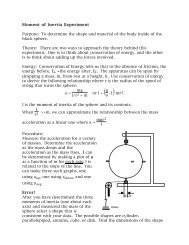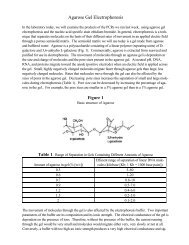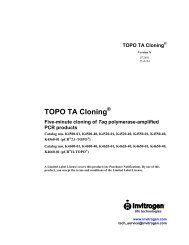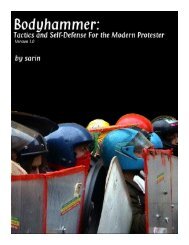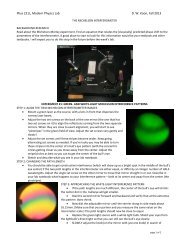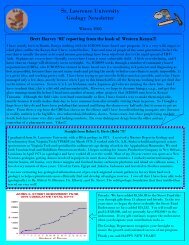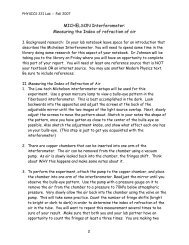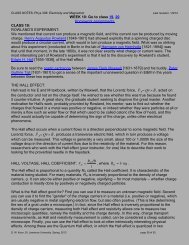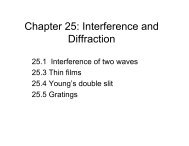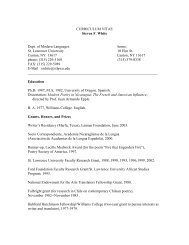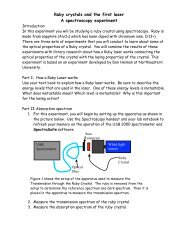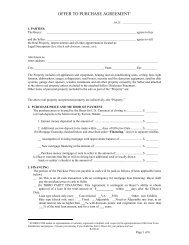HOOKE'S LAW AND A SIMPLE SPRING - St. Lawrence University
HOOKE'S LAW AND A SIMPLE SPRING - St. Lawrence University
HOOKE'S LAW AND A SIMPLE SPRING - St. Lawrence University
You also want an ePaper? Increase the reach of your titles
YUMPU automatically turns print PDFs into web optimized ePapers that Google loves.
INTRODUCTIONIf it is not stretched to the point where it becomes permanently deformed, thebehavior of a properly wound coiled spring, when subjected to a stretching force, can beexpected to follow Hooke's Law. [Bueche, p. 95] (Note that Hooke's Law applies moregenerally to many more systems than just ordinary springs.) To see whether an ordinaryscreen door spring behaves similarly, one such spring was suspended by one end froma horizontal support and masses were hung from its other end to stretch it as shown inFigure 1. The resulting data were used to construct a graph of load as a function ofelongation, from which it was possible to obtain the spring constant of the spring. Inaddition, for one value of load the spring was given a small additional stretch andreleased, thereby setting the system into vertical oscillation. Assuming this motion to besimple harmonic, its period also yields a spring constant, thereby providing an additionalcheck.Note the difference between the abstract and the introduction. The introduction indicates theprimary thrust of the experiment but does not indicate results. It does not have to stand by itselfand can refer to later parts of the report such as a diagram or a graph. Such reference shouldbe to a numbered figure or graph. (Figure 1 in this example)THEORYIt is essential that the theory section be written for the particular audience for which the report isintended. In this case, imagine your audience to consist of one of your classmates who had tomiss this week’s lab.If a weight, W = mg, is hung from one end of an ordinary spring, causing it tostretch a distance x, then an equal and opposite force, F, is created in the spring whichacts to oppose the pull of the weight. If W is not so large as to permanently distort thespring, then this force, F, will restore the spring to its original length after the load isremoved. F is thus called an elastic force and it is well known that the magnitude of anelastic restoring force is directly proportional to the stretch,F = kxNote how all quantities are defined when they first appear. Notice how the author uses italicsto set off physical quantities from the rest of the text.A relationship called Hooke's Law after the 17th century scientist who studied it. Theconstant k is called the spring constant, or stiffness coefficient. To emphasize that xrefers to the change in length of the spring we writeF = mg = kΔ l. (1)In this form it is apparent that if a plot of F as a function of Δ l has a linear portion, thisprovides confirmation that the spring follows Hooke's Law [Bueche, p. 226] and enablesus to find k.2



